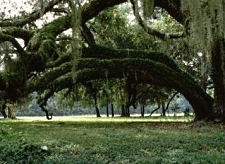Wildlife - Species

Live Oak (Quercus virginiana)
Description
Live oak belongs to the beech family (Fagaceae). Live oaks are medium-sized evergreen trees with wide-spreading branches and dark, slightly ridged bark. The leaves are simple and thick with entire and curled margins. Live oaks are monoecious (flowers contain either male or female reproductive parts). The flowers grow in the axis of leaves: male flowers in clustered, drooping catkins, and female flowers on a short spike. Live oak leaves have a high content of fiber and are covered by dense hairs on the underside and cuticle (a waxy substance) on the upper side which protect the leaves from salt-laden breezes that would kill most other trees.
Preferred Habitat and Biology
Live oaks are found from Virginia to Florida and westward to Mississippi, where they grow in sandy soils on the coastal plain. In the ACE Basin, live oak is the dominant species in the maritime forests because of its tolerance to salt spray.
The growing season of live oak lasts about seven months, beginning in late February and continuing through late September. Radial growth begins before the leaves emerge, and in many cases, the rate of growth reaches its peak after the leaves are fully mature. The growth rate then levels off and continues at a fairly steady rate for the next 100 days or so. Over 50% of new radial growth occurs during this period of maximum growth.
Species Significance
Live oak acorns are eaten by many animals, especially during winter. They are consumed by upland game birds such as the bobwhite and wild turkey and are an important component of the diet of gray squirrels and grackles. Other animals known to eat live oak acorns include raccoons, gray foxes and rabbits. In the north, larger mammals, including the black bear, white-tailed deer and elk, are known to consume the fruits. During the colonial period, live oaks were important lumber trees. Shipbuilders would cut curved pieces from the junction of the limb and trunk and use the pieces for ribs in wooden ships. It has also been a favorite ornamental tree since the 1700s. Trees planted over 200 years ago are still in existence today. Live oaks are common throughout their range. During the antebellum period, plantation owners planted these trees on their property, especially along the main roads leading to their estates, and many of them are still alive today.
References
Eggler, W.A. 1955. Radial growth in nine species of trees in southern Louisiana. Ecology 36(1):130-136.
Martin, A.C., H.S. Zim, and A.L. Nelson. 1951. American wildlife and plants: A guide to wildlife food habits. Dover Publications Inc., New York, NY.
Porcher, R.D. 1995. Wildflowers of the Carolina Lowcountry and lower Pee Dee. University of South Carolina Press, Columbia, SC.
Radford, A.E., H.E. Ahles, and C.R. Bell. 1968. Manual of the vascular flora of the Carolinas. The University of North Carolina Press, Chapel Hill, NC.
